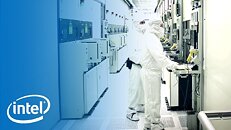Friday, January 22nd 2021

Intel Has Fixed its 7 nm Node, But Outsourcing is Still Going to Happen
Intel has today reported its Q4 2020 earnings disclosing full-year revenue with the current CEO Bob Swan, upcoming new CEO Pat Gelsinger, and Omar Ishrak, Chairman of Intel's board. During the call, company officials have talked about Intel's earnings and most importantly, addressing the current problems about the company's manufacturing part - semiconductor foundries. Incoming Intel CEO, Pat Gelsinger, has talked about the state of the 7 nm node, giving shareholders reassurance and a will to remain in such a position. He has made an argument that he has personally reviewed the progress of the "health and recovery of the 7 nm program."
The 7 nm node has been originally delayed by a full year amid the expectations, and as with the 10 nm node, we have believed that it is going to experience similar issues. However, the incoming CEO has reassured everyone that it is very much improving. The new 7 nm node is on track for 2023 delivery, when Intel is expected to compete with the 3 nm node of TSMC. Firstly, Intel will make a debut of the 7 nm node with client processors scheduled for 1H 2023 arrival, with data center models following that. The company leads have confirmed that Intel will stay true to its internal manufacturing, but have stressed that there will still be a need for some outsourcing to happen.
Source:
Tom's Hardware
The 7 nm node has been originally delayed by a full year amid the expectations, and as with the 10 nm node, we have believed that it is going to experience similar issues. However, the incoming CEO has reassured everyone that it is very much improving. The new 7 nm node is on track for 2023 delivery, when Intel is expected to compete with the 3 nm node of TSMC. Firstly, Intel will make a debut of the 7 nm node with client processors scheduled for 1H 2023 arrival, with data center models following that. The company leads have confirmed that Intel will stay true to its internal manufacturing, but have stressed that there will still be a need for some outsourcing to happen.

65 Comments on Intel Has Fixed its 7 nm Node, But Outsourcing is Still Going to Happen
What the hell is going on there? Anyone knows what the REAL problem is?
[Youtube]
Make sure to stick around until 1:50.
0. Electrical migration.
1. Too much transistors on too small area. Heat density is tremendous.
2. Defective yields percentage.
3. Low quality "engineers".
4. Intel inside.
+ Investors decisions.
+ Owners decisions.
+ State rules.
Then they slowly over time lost their manufacturing advantage and their competitiveness has been negated.
They have themselves to blame.
Hopefully the new guy sorts their engineering out then they can move forward on their own nodes though a press release ten minutes after he starts saying the clouds are clearing just smells like same shit different day/guy.
Heard this song before.
Now, provided it definitely beats 7nm TSMC and likely 5nm too, a tad too far for a "fixed" node.
So AMD should continue to lead, though competition is quite healthy right now. I don't see as much Intel shenanigans as before, as of late.
Pat G is taking over and suddenly Intel gets to repeat the same bullshit they have until now. Its just another escalation to keep shareholders on board. Pat is just repackaging the same messages here... I doubt the intel world suddenly changed because Bob leaves the building.Exactly. In the meantime they told us we would get:
- super storage (optane) = dead
- ARM adventure = never materialized
- IoT = nothing more than a one off at best (dev boards)
- 10nm = still trying to keep it from a total trainwreck, but will not clock or perform better than 14nm at all)
- 7nm = fantasy land, a repeat of the same BS we heard about 10nm
- Foveros... massive xeons that look like something literally welded together... a dozen lakes and coves... backports snd biglittle yet none of it really convincing.. total lack of direction or focus.
Realistically Intel only has its legacy business and its volume/production capability to keep them afloat going forward. Ultrabooks are however slowly getting replaced and Apple will push that ARM button ever harder.